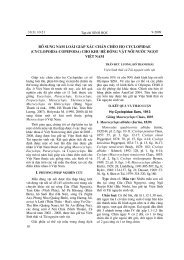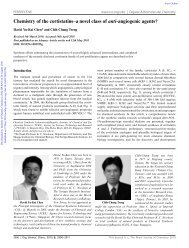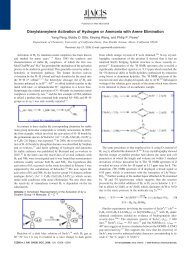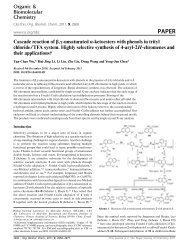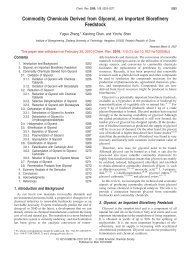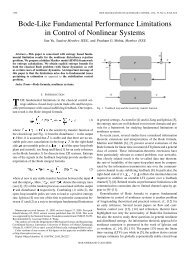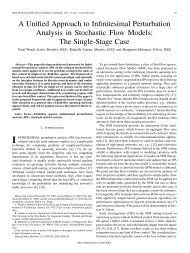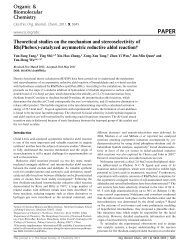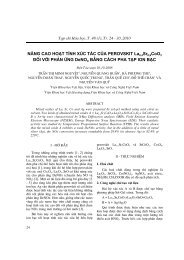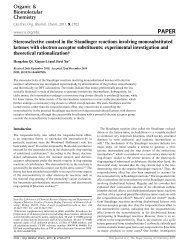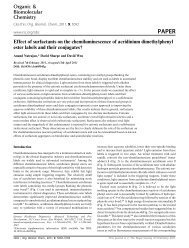uril and cucurbit[8]uril
uril and cucurbit[8]uril
uril and cucurbit[8]uril
Create successful ePaper yourself
Turn your PDF publications into a flip-book with our unique Google optimized e-Paper software.
Organic &<br />
Biomolecular<br />
Chemistry<br />
www.rsc.org/obc Volume 8 | Number 9 | 7 May 2010 | Pages 1977–2268<br />
ISSN 1477-0520<br />
FULL PAPER<br />
Werner M. Nau et al.<br />
Toxicity of <strong>cucurbit</strong>[7]<strong>uril</strong> <strong>and</strong><br />
<strong>cucurbit</strong>[8]<strong>uril</strong>: an exploratory in vitro<br />
<strong>and</strong> in vivo study<br />
FULL PAPER<br />
Sujay P. Sau, T. Santhosh Kumar <strong>and</strong><br />
Patrick J. Hrdlicka<br />
Invader LNA: Efficient targeting of<br />
short double str<strong>and</strong>ed DNA
PAPER www.rsc.org/obc | Organic & Biomolecular Chemistry<br />
Toxicity of <strong>cucurbit</strong>[7]<strong>uril</strong> <strong>and</strong> <strong>cucurbit</strong>[8]<strong>uril</strong>: an exploratory<br />
in vitro <strong>and</strong> in vivo study<br />
Vanya D. Uzunova, a Carleen Cullinane, b Klaudia Brix, a Werner M. Nau* a <strong>and</strong> Anthony I. Day* c<br />
Received 4th December 2009, Accepted 26th January 2010<br />
First published as an Advance Article on the web 17th February 2010<br />
DOI: 10.1039/b925555a<br />
Cucurbit[n]<strong>uril</strong>s (CB[n]) are potential stabilizing, solubilizing, activating, <strong>and</strong> delivering agents for<br />
drugs. The toxicity of the macrocyclic host molecules <strong>cucurbit</strong>[7]<strong>uril</strong> (CB[7]), the most water-soluble<br />
homologue, as well as <strong>cucurbit</strong>[8]<strong>uril</strong> (CB[8]) has been evaluated. In vitro studies on cell cultures<br />
revealed an IC 50 value of 0.53 ± 0.02 mM for CB[7], corresponding to around 620 mg of CB[7] per kg of<br />
cell material. Live-cell imaging studies performed on cells treated with subtoxic amounts of CB[7]<br />
showed no detrimental effects on the cellular integrity as assessed by mitochondrial activity. For CB[8],<br />
no significant cytotoxicity was observed within its solubility range. The bioadaptability of the<br />
compounds was further examined through in vivo studies on mice, where intravenous administration of<br />
CB[7] showed a maximum tolerated dosage of 250 mg kg -1 , while oral administration of a CB[7]/CB[8]<br />
mixture showed a tolerance of up to 600 mg kg -1 . The combined results indicate a sufficiently low<br />
toxicity to encourage further exploration of CB[n] as additives for medicinal <strong>and</strong> pharmaceutical use.<br />
1. Introduction<br />
Macrocyclic host molecules have the potential to encapsulate biologically<br />
relevant guests <strong>and</strong> act as drug carriers, drug solubilizers,<br />
drug stabilizers, <strong>and</strong> drug bioavailability enhancers. This strategy<br />
has been extensively explored both for naturally occurring hosts<br />
such as cyclodextrins, 1,2 as well as for synthetic molecular receptors<br />
such as calixarenes <strong>and</strong> crown ethers. 3,4 A very promising emerging<br />
class of synthetic molecular hosts are <strong>cucurbit</strong>[n]<strong>uril</strong>s (CB[n]).<br />
CB[n] are macrocyclic containers formed by acid-catalyzed condensation<br />
of n glycol<strong>uril</strong> units with formaldehyde. 5 Although first<br />
made in 1905, 5 the interest towards the CB[n] family has only<br />
grown after the full characterization of the parent compound<br />
<strong>cucurbit</strong>[6]<strong>uril</strong> (CB[6]) in 1981. 6 Subsequently, larger <strong>and</strong> smaller<br />
homologues have been characterized, such that the CB[n] family<br />
nowadays comprises CB[5], CB[6], CB[7], CB[8], <strong>and</strong> CB[10]. 7-10<br />
All CB[n] homologues have highly symmetrical structures with a<br />
hydrophobic cavity, accessible on both sides through two identical<br />
carbonyl-rimmed portals (Fig. 1). They function as molecular<br />
containers forming strong noncovalent 1 : 1 as well as 2 : 1 host–<br />
guest inclusion complexes with neutral <strong>and</strong> positively charged<br />
organic molecules. 10,11<br />
Several biologically <strong>and</strong> pharmaceutically relevant applications<br />
of <strong>cucurbit</strong><strong>uril</strong>s, particularly of CB[7], have been recently<br />
reported. 12–49 With respect to interactions with biomolecules,<br />
<strong>cucurbit</strong><strong>uril</strong>s have been shown to form host–guest inclusion<br />
a School of Engineering <strong>and</strong> Science, Jacobs University Bremen, Campus<br />
Ring 1, D-28759, Bremen, Germany. E-mail: w.nau@jacobs-university.de;<br />
Fax: (49) 4212003229<br />
b Research Division, Peter MacCallum Cancer Centre, Locked Bag No 1,<br />
A’Beckett Street, Melbourne, VIC 8006, Australia. E-mail: carleen.<br />
cullinane@petermac.org; Fax: (61) 396561411<br />
c School of Physical, Environmental <strong>and</strong> Mathematical Sciences,<br />
UNSW@ADFA, Australian Defence Force Academy, Northcott Drive,<br />
Campbell, ACT 2600, Australia. E-mail: a.day@adfa.edu.au; Fax: (61)<br />
262688017<br />
Fig. 1 Structure of <strong>cucurbit</strong>[7]<strong>uril</strong> (CB[7]).<br />
complexes with selected naturally occurring amino acid residues, 12<br />
which has been used to recognize <strong>and</strong> self-sort sequences of<br />
short peptides. 13-17 Cucurbit<strong>uril</strong>–dye reporter pairs have been<br />
successfully employed for assaying the activity of enzymes 18–20<br />
<strong>and</strong> for amino acid sensing. 21 Cucurbit<strong>uril</strong>s have also shown the<br />
potential to bind with either peptide substrates 22 or inhibitors 23<br />
<strong>and</strong> in this way affect the activity of enzymes. Cucurbit<strong>uril</strong>s have<br />
also been employed to immobilize proteins on surfaces by noncovalent<br />
interactions. 24 Furthermore, <strong>cucurbit</strong><strong>uril</strong>s have shown the<br />
capability to refold synthetic oligomers under chemical stimuli<br />
response. 25 The fluorescence enhancement <strong>and</strong> photostabilization<br />
of different dye molecules upon <strong>cucurbit</strong><strong>uril</strong> encapsulation provides<br />
additional potential for biological analysis. These features<br />
are crucial for imaging microscopy applications where improved<br />
biological fluorescence markers are in high dem<strong>and</strong>. This last<br />
strategy has been applied to several commonly used dyes such<br />
as Rhodamine 6G, 26–28 as well as Brilliant Green <strong>and</strong> Neutral Red<br />
in combination with proteins. 29,30<br />
With respect to potential pharmaceutical applications, <strong>cucurbit</strong><strong>uril</strong>s<br />
have also exerted beneficial effects upon interaction with<br />
different classes of drugs. An extensively investigated class of drug<br />
This journal is © The Royal Society of Chemistry 2010 Org. Biomol. Chem., 2010, 8, 2037–2042 | 2037
molecules are the platinum-based anticancer drugs, where <strong>cucurbit</strong><strong>uril</strong><br />
encapsulation has been used in an attempt to reduce their<br />
toxicity, 31 to act as a drug delivery vehicle that would specifically<br />
target cancerous cells, <strong>and</strong> to improve drug solubility, stability,<br />
or specificity. 32–37 No cytotoxic effects of CB[7] have become<br />
obvious from those studies. The poorly soluble organic cytotoxic<br />
drugs albendazole <strong>and</strong> camptothecin also showed improved<br />
properties in vitro when encapsulated in CB[7] <strong>and</strong> CB[8]. 38,39<br />
Another prominent example is CB[7] complexation of several<br />
drugs administrated through the gastrointestinal tract, such as<br />
lansoprazole <strong>and</strong> omeprazole; their encapsulation in <strong>cucurbit</strong><strong>uril</strong><br />
shifts the pK a values of these drugs, thereby improving their activation<br />
<strong>and</strong> stabilization. 40 The histamine H 2-receptor antagonist<br />
ranitidine shows a pK a shift through encapsulation <strong>and</strong> is thereby<br />
stabilized. 41 Similarly, the local anaesthetics procaine, tetracaine,<br />
procainamide, dibucaine, <strong>and</strong> prilocaine also increase their pK a<br />
values upon CB[7] encapsulation. 42 With respect to peptidebased<br />
drugs, <strong>cucurbit</strong><strong>uril</strong>s have also shown preservation effects<br />
on peptide substrates by inhibiting their enzymatic hydrolysis. 22<br />
Moreover, <strong>cucurbit</strong><strong>uril</strong>s have been proposed as carriers in gene<br />
delivery, 43 <strong>and</strong> in drug delivery by employing multivalent vesicles<br />
formed from amphiphilic CB[6] derivatives. 44 Two examples of<br />
CB[7] complexation of the vitamins B 2 <strong>and</strong> B 12 have also been<br />
reported. 45,46 Furthermore, a recent study has indicated that<br />
CB[n]–dye complexes are able to cross the cell membrane of mouse<br />
embryo cells. 47<br />
Surprisingly, although the number of biologically related <strong>cucurbit</strong><strong>uril</strong><br />
applications is dramatically increasing, the intrinsic toxicity<br />
of <strong>cucurbit</strong><strong>uril</strong> macrocycles, which constitutes a critical parameter<br />
for their pharmaceutical use, has not been reported until now.<br />
Herein, we present a toxicity profile of <strong>cucurbit</strong><strong>uril</strong>s, in particular<br />
<strong>cucurbit</strong>[7]<strong>uril</strong> (CB[7]), based on an in vitro cytotoxicity assay, supported<br />
by live-cell imaging microscopy, <strong>and</strong> combined with an in<br />
vivo oral <strong>and</strong> intravenous administration study on mice. The CB[7]<br />
homologue has been selected for the cytotoxicity <strong>and</strong> intravenous<br />
studies since it possesses the highest solubility in aqueous solution<br />
of the known homologues 48,49 <strong>and</strong> is, consequently, an obvious first<br />
choice for drug-related applications. CB[7] is also sufficiently large<br />
to fully or at least partially include numerous common drugs, a<br />
precondition which is not fulfilled for the smaller water-soluble<br />
CB[5] <strong>and</strong> poorly water-soluble CB[6] homologues. The larger<br />
CB[8] has most potential as an oral drug delivery vehicle, where<br />
dissolution of this poorly water-soluble macrocycle would present<br />
no principal limitation. In general, the thermal stability of CB[7]<br />
<strong>and</strong> CB[8] in the pH range 1.3–9.0, that of the gastrointestinal<br />
tract, makes them ideal c<strong>and</strong>idates for oral applications. 10,50<br />
2. Results <strong>and</strong> discussion<br />
We have designed our experimental study such that we initially<br />
tested the toxicity of CB[7] <strong>and</strong> CB[8] in cell culture in order to<br />
determine the subtoxic dosage of the compound. We then worked<br />
in the identified subtoxic range to monitor the effect of CB[7]<br />
incubation on the integrity <strong>and</strong> metabolic activity of viable cells<br />
by fluorescence microscopy. The scope of the investigation was<br />
augmented by in vivo studies on mice. Firstly, a maximum tolerated<br />
dose (MTD) was determined by performing CB[7] intravenous<br />
injection, <strong>and</strong> subsequently the effect of oral administration of a<br />
1 : 1 mixture of CB[7] <strong>and</strong> CB[8] was investigated.<br />
2.1 In vitro cytotoxicity <strong>and</strong> effect of metabolic activity<br />
The <strong>cucurbit</strong><strong>uril</strong>-induced cytotoxicity was measured in an MTT<br />
assay on Chinese Hamster Ovary (CHO-K1) cells. The MTT<br />
3-(4,5-dimethylthiazol-2-yl)-2,5-diphenyltetrazolium bromide) assay<br />
presents a quantitative colorimetric method for studying<br />
cytotoxic agents, where the amount of MTT reduced by cells to its<br />
blue formazan derivative is quantified spectroscopically at 570 nm<br />
<strong>and</strong> is equivalent to the number of viable cells. 51,52 In order to<br />
determine the subtoxic levels of CB[7], we screened a broad range<br />
of CB[7] concentrations (0.1–4.5 mM) by dissolving the additive<br />
in the cell culture medium <strong>and</strong> incubating CHO-K1 cells for a<br />
period of 48 h. Concentrations above 2 mM were found to inhibit<br />
cell proliferation, while concentrations below 1 mM were tolerable<br />
(data not shown). To determine the exact concentration of CB[7]<br />
exhibiting cytotoxic effects, we investigated the subtoxic range<br />
of up to 1 mM for the same time interval of 2 days (Fig. 2A),<br />
relative to a control sample lacking CB[7], <strong>and</strong> obtained an<br />
IC 50 value of 0.53 ± 0.02 mM. The IC 50 value, which represents<br />
the concentration of CB[7] at which the cell viability is 50% of<br />
the viability at control conditions, corresponds to approximately<br />
620 mg of CB[7] per kg of CHO-K1 cells, a number that can be<br />
more directly compared to the oral <strong>and</strong> intravenous studies (see<br />
below). Similar studies were performed over 48 h for CB[8] as<br />
additive, but due to the lower solubility of this macrocycle the<br />
accessible concentration range was limited (Fig. 3). At the highest<br />
Fig. 2 Relative cell viability of CHO-K1 cells in dependence on CB[7] concentration (0–1 mM) <strong>and</strong> incubation time determined using the MTT assay<br />
by monitoring formazan absorbance at 570 nm. Mean values <strong>and</strong> st<strong>and</strong>ard deviations were obtained from five independent experimental determinations.<br />
2038 | Org. Biomol. Chem., 2010, 8, 2037–2042 This journal is © The Royal Society of Chemistry 2010
Fig. 3 Relative cell viability of CHO-K1 cells in dependence on CB[8]<br />
concentration (0–20 mM) after 48 h incubation time determined using the<br />
MTT assay by monitoring formazan absorbance at 570 nm. Mean values<br />
<strong>and</strong> st<strong>and</strong>ard deviations were obtained from five independent experimental<br />
determinations.<br />
investigated concentration of 20 mM after 48 h (the solubility limit<br />
in the employed cell culture medium), the relative cell viability<br />
dropped marginally to 86 ± 7%. While this effect is too small to<br />
rigorously substantiate an emerging cytotoxic effect, it prevented<br />
in any case an accurate determination of the IC 50 value of CB[8].<br />
Next, we examined the cytotoxicity effect of CB[7] within 3 h of<br />
administration (Fig. 2B). This time scale is particularly relevant for<br />
fluorescence microscopic imaging applications of cells <strong>and</strong> tissues,<br />
where st<strong>and</strong>ard incubation times range from minutes to hours. 53<br />
Recall, in this context, that CB[7] has been suggested as an additive<br />
to increase the brightness <strong>and</strong> photostability of fluorescent dyes<br />
used for fluorescence staining, 26–30 a prospective application which<br />
is greatly facilitated by the absence of cytotoxic effects as well as<br />
other detrimental effects on cellular integrity. Indeed, at shorter<br />
incubation times even a higher CB[7] concentration of 1 mM<br />
was found to be tolerable. For comparison, administration of<br />
CB[8] caused no reduction in cell viability over the shorter (3 h)<br />
incubation time.<br />
We further examined the effect of CB[7] on the metabolic<br />
activity of living cells when working near the IC 50 concentration<br />
at short incubation times. For this purpose, the mitochondria<br />
of CHO-K1 cells were stained with MitoTracker Red CMXRos,<br />
a membrane potential-dependent probe, which can selectively<br />
distinguish metabolically active mitochondria. 54,55 The integrity of<br />
mitochondria was studied by fluorescence microscopy (Fig. 4).<br />
To exclude possible artifacts due to interaction of the probe<br />
with CB[7], e.g., due to inclusion complex formation, 26–30 we<br />
conducted the experiments by varying the sequence of addition,<br />
i.e. MitoTracker incubations followed by CB[7] <strong>and</strong> vice versa<br />
(Fig. 4B <strong>and</strong> C, respectively). Mitochondrial activity was found to<br />
be retained under all experimental conditions since they preserved<br />
the characteristic elongated spaghetti-like structure through the<br />
cytosol as seen in the control sample containing no CB[7]<br />
(Fig. 4A). Overall inspection of the micrographs showed that the<br />
cellular architecture <strong>and</strong> integrity was preserved in the presence<br />
of CB[7], e.g., no signs characteristic for necrosis or apoptosis like<br />
rupture or plasma membrane blebbing were observed. To sum up,<br />
no cytotoxic effects were observed at a concentration of 0.5 mM<br />
CB[7] applied in complete culture medium.<br />
The results of the cytotoxicity study with cultured mammalian<br />
cells clearly indicated that CB[7] exhibits almost no cytotoxicity<br />
when administered over 2 days at concentrations below 0.5 mM<br />
(Fig. 2A), with concentrations of 1 mM being tolerable for<br />
shorter time periods in the range of few hours (Fig. 2B). Higher<br />
concentrations lead to decreased cell proliferation. The live-cell<br />
imaging studies further revealed no signs of cytotoxicity when<br />
working near the IC 50 value (0.53 mM). Most importantly, after<br />
treatment with subtoxic CB[7] amounts, the metabolic activity<br />
of the cells was preserved, indicated by the intact structure of<br />
mitochondria <strong>and</strong> by their ability to maintain an intact membrane<br />
potential across the inner mitochondrial membrane, which is a<br />
prerequisite in order to accumulate the MitoTracker probe within<br />
the mitochondrial matrix (Fig. 4). CB[8] showed no significant<br />
Fig. 4 Micrographs depicting staining of the mitochondria with MitoTracker Red CMXRos in metabolically active CHO-K1 cells: (A) MitoTracker<br />
applied without CB[7] as a control; (B) incubation with MitoTracker (45 min), then 0.5 mM CB[7] (30 min); (C) incubation with 0.5 mM CB[7] (30 min),<br />
then MitoTracker (45 min). Every micrograph includes a black-<strong>and</strong>-white magnified image of the fluorescence signal of individual cells (upper panels,<br />
10 mm scale bar), as well as fluorescence <strong>and</strong> phase contrast images as overviews (lower panels, 50 mm scale bar). White arrows indicate the elongated<br />
spaghetti-like structures of the mitochondria.<br />
This journal is © The Royal Society of Chemistry 2010 Org. Biomol. Chem., 2010, 8, 2037–2042 | 2039
cytotoxicity within its solubility range (up to 20 mM) after<br />
2days.<br />
2.2 In vivo toxicity by intravenous <strong>and</strong> oral administration<br />
The effect of intravenous administration was only investigated<br />
for CB[7], because of the limited solubility <strong>and</strong> the absence of<br />
an observable cytotoxic effect of the larger homologue CB[8].<br />
Specifically, the effect of a single intravenous dose of CB[7] on<br />
mouse body weight was investigated at doses of up to 300 mg kg -1<br />
(Fig. 5). No toxicity (assessed <strong>and</strong> defined here as 10% weight<br />
loss) up to levels of 200 mg kg -1 was observed. At higher doses<br />
<strong>and</strong> fast injection, however, the mice went into a shock-like state<br />
immediately after dosing. The maximum tolerated dose of CB[7]<br />
was consequently established at the 250 mg kg -1 dose level when<br />
the compound was administered as a slow intravenous push.<br />
Fig. 5 Effects of CB[7] on mouse body weight over days at the MTD of<br />
250 mg kg -1 administered by slow intravenous push.<br />
The effects observed for an intravenous single dosing in<br />
vivo demonstrate that CB[7] has a very low acute toxicity of<br />
250 mg kg -1 . Significantly, all of the mice injected with slow<br />
infusion into the vein began recovery after 5–8 days. It was beyond<br />
the scope of this study to determine the fate of CB[7], but the<br />
recovery of the mice may indicate a clearing of CB[7] from the<br />
body by either excretion or metabolism. As a drug delivery vehicle<br />
or as a biological tool this is certainly a desirable feature.<br />
Potential pharmaceutical applications of CB[7] (as well as<br />
CB[8]) would need to compete with those already established<br />
with b-cyclodextrin (b-CD), which has a similarly large cavity <strong>and</strong><br />
could include similarly large drugs. Intuitively, one would expect<br />
a higher toxicity for the former synthetic host when compared to<br />
the latter naturally occurring <strong>and</strong> a-D-glucose based one. Indeed,<br />
the synthetic CB[7] macrocycle shows a slightly lower intravenous<br />
tolerance than b-CD, for which an LD 50 value of ca. 790 mg kg -1<br />
has been reported. 56 However, the difference is surprisingly small,<br />
especially if one takes into account that the MTD of CB[7]<br />
(250 mg kg -1 ) is not equivalent to an LD 50 value but corresponds<br />
to a sub-lethal effect on long-term growth <strong>and</strong> recovery, which lies<br />
generally well below the LD 50. Moreover, any applications relying<br />
on the supramolecular encapsulation of drugs would depend on<br />
the association constants of the host, which are generally much<br />
higher for CB[7] (10 4 –10 7 M -1 ) 10 than for b-CD (10 1 –10 4 M -1 ). 57<br />
A smaller amount of CB[7] would consequently be required to<br />
efficiently complex a given amount of drug. For example, the<br />
albendazole drug requires >6 times higher concentration of b-CD<br />
than CB[7] to achieve the same solubility. 38,58,59 Moreover, the two<br />
macrocycles differ substantially with respect to their selectivity<br />
<strong>and</strong> binding preferences. Accordingly, they could be used in a<br />
complementary manner to bind, for example, cationic (for CB[7])<br />
versus hydrophobic residues (for b-CD) in peptide-based drugs. 22<br />
Finally, as discussed in the introduction, CB[7] possesses a high<br />
solubility in water, which is further increased in the presence of<br />
metal ions, as they would be ubiquitous in physiological media. 60<br />
This salt-dependent solubility offers further advantages of the<br />
macrocycle as a drug delivery agent, on one h<strong>and</strong> to improve<br />
solubility profiles of encapsulated drugs, 38–40 on the other h<strong>and</strong><br />
to reduce the risk of any undesirable precipitation (salting out)<br />
in vivo.<br />
For the oral administration studies the body weight change<br />
with time was monitored for mice, which had been fed a single<br />
dose of 600 mg kg -1 of a 1 : 1 CB[7]/CB[8] mixture. Both CB[7]<br />
<strong>and</strong> CB[8] are promising additives for the oral administration of<br />
drugs <strong>and</strong> were consequently studied in parallel, also with the<br />
intention to limit the amounts of test animals. Fortunately, no<br />
significant toxicity, as assessed by lack of weight loss, was observed.<br />
Thus, the MTD for the combined <strong>cucurbit</strong><strong>uril</strong> mixture by the oral<br />
route is in excess of 600 mg kg -1 or, excluding the very unlikely<br />
possibility of an interaction between these two hosts, in excess of<br />
300 mg kg -1 CB[7] as well as CB[8]. The complete lack of any<br />
toxic effects observed for the oral single dosing demonstrated that<br />
the toxicity via this route is even lower than that for intravenous<br />
administration. Presumably, this points to a low absorption of<br />
<strong>cucurbit</strong><strong>uril</strong> across the gastrointestinal tract into the blood stream.<br />
The alternative explanation, a destruction of the macrocycle in the<br />
gastrointestinal tract, appears highly unlikely in view of the high<br />
chemical stability of <strong>cucurbit</strong><strong>uril</strong>s. 10 The intrinsic stability of CB[n]<br />
macrocycles provides another important feature for their use as<br />
drug delivery agents since it could also influence <strong>and</strong> improve the<br />
gastrointestinal stability of the complexed drugs.<br />
3. Conclusions<br />
Our combined results demonstrate a very low toxicity of the<br />
macrocyclic compounds CB[7] <strong>and</strong> CB[8] through in vitro studies<br />
in CHO-K1 cells <strong>and</strong> in vivo intravenous injection, as well as<br />
oral administration studies on mice. The IC 50 <strong>and</strong> MTD values<br />
are mutually consistent <strong>and</strong> suggest that CB[7] is essentially<br />
nontoxic when applied in concentrations below 250 mg kg -1<br />
tissue or body weight, or below concentrations of 0.5 mM, which<br />
would be far above the concentrations required for drug delivery<br />
applications. The potential benefits that can be imparted upon<br />
a pharmacological agent by <strong>cucurbit</strong>[n]<strong>uril</strong> such as improved<br />
solubility, stability, <strong>and</strong> specificity are consequently reinforced by<br />
our present finding of a low cytotoxicity.<br />
4. Experimental<br />
In vitro studies with CB[7]<br />
Acetone, ethanol, absolute ethanol <strong>and</strong> paraformaldehyde were<br />
purchased from AppliChem GmbH (Darmstadt, Germany). 4-<br />
(2-Hydroxyethyl)piperazine-1-ethanesulfonic acid (HEPES) <strong>and</strong><br />
2040 | Org. Biomol. Chem., 2010, 8, 2037–2042 This journal is © The Royal Society of Chemistry 2010
10 times concentrated phosphate buffered saline (PBS) were purchased<br />
from Carl Roth GmbH (Karlsruhe, Germany). Dimethyl<br />
sulfoxide (DMSO), 1-(4,5-dimethylthiazol-2-yl)-3,5-diphenylformazan<br />
(MTT Formazan) <strong>and</strong> 1% penicillin–streptomycin solutions<br />
were all purchased from Sigma-Aldrich Chemie GmbH<br />
(Taufkirchen, Germany). Ham’s F12 medium was purchased<br />
from CC Pro (Neustadt/Weinstrasse, Germany). MitoTracker<br />
Red CMXRos (M-7512) <strong>and</strong> 10% fetal calf serum (FCS) were purchased<br />
from Gibco TM Invitrogen GmbH (Karlsruhe, Germany).<br />
CB[7] was synthesized according to previously reported literature<br />
procedures. 7,8,61 Flasks, cell culture flasks, <strong>and</strong> 6- or 24-well plates<br />
were purchased from Nunc (via OmniLab-Laborzentrum GmbH<br />
& Co. KG, Bremen, Germany).<br />
All cell culture manipulations were performed in a sterile<br />
environment using a Hera safe cell culture bench (KS12, Kendro<br />
Laboratory Products GmbH, Langenselbold, Germany). The cells<br />
were kept <strong>and</strong> manipulated under st<strong>and</strong>ard conditions of 37 ◦ C<br />
in 5% CO 2 atmosphere using a CB 210 CO 2-incubator (Binder<br />
GmbH, Tuttlingen, Germany). Chinese Hamster Ovary Cells<br />
(CHO-K1) were grown in Ham’s F12 medium, supplemented with<br />
10% FCS <strong>and</strong> a 1% penicillin–streptomycin solution. The Ham’s<br />
F12 medium <strong>and</strong> Ham’s F12 medium without phenolred were<br />
purchased from CC Pro (Neustadt/Weinstrasse, Germany).<br />
Cytotoxicity assay (MTT test)<br />
Cells were seeded in 24-well plates at a density of 500 cells per<br />
microlitre <strong>and</strong> incubated for periods of 48 h with a range of<br />
CB[7] (0.1–4.5 mM) <strong>and</strong> CB[8] (4–20 mM) concentrations in<br />
complete culture medium. For the 3 h CB[7]-incubation period<br />
cells were grown for 45 h with addition of CB[7] containing media<br />
in the last 3 h. The MTT cytotoxicity assay was performed by<br />
adding 100 mL ml -1 of an MTT solution (5 mg ml -1 )toeach<br />
well <strong>and</strong> incubating for 2.5 h. The MTT-containing media were<br />
discarded <strong>and</strong> 1 ml of DMSO was added to each well. The<br />
absorbance of the formazan dye was measured at 570 nm with<br />
a Spectronic Genesys 10 spectrophotometer (Fisher Scientific<br />
GmbH, Schwerte, Germany). The IC 50 value was calculated from<br />
the obtained dose-response curve by sigmoidal fitting.<br />
Live-cell imaging<br />
The cells were plated on glass coverslips in 6-well plates at a<br />
density of 1000 cells per microlitre, incubated for 12 h until they<br />
reached 70% confluency, <strong>and</strong> washed with 1 ml HEPES-buffered<br />
culture medium (20 mM HEPES) for 3 min. The cells were stained<br />
with 500 nM of MitoTracker Red CMXRos solution for 45 min,<br />
washed with HEPES-buffered culture medium, <strong>and</strong> subsequently<br />
incubated with 0.5 mM CB[7] for 30 min. For the experiment<br />
with reverse addition, the cells were first incubated with 0.5 mM<br />
CB[7] for 30 min, washed with HEPES-buffered culture medium,<br />
<strong>and</strong> then stained with 500 nM of MitoTracker Red CMXRos<br />
solution for 45 min. For direct observation of the living cells under<br />
the fluorescence microscope, cells were washed in pre-warmed<br />
PBS <strong>and</strong> immersed in HEPES-buffered culture media without<br />
phenolred. Phase-contrast <strong>and</strong> fluorescent images with resolutions<br />
of 1024 ¥ 1024 pixels were taken using an Axiovert 25 fluorescence<br />
microscope (Carl Zeiss AG, Oberkochen, Germany), equipped<br />
with an HBO lamp with an excitation wavelength of 543 nm. The<br />
scans were obtained with a 40-fold magnification <strong>and</strong> an exposure<br />
time of 1.22 s. Color-coding <strong>and</strong> image analysis was performed<br />
using the Axio Vision LE Rel. Image Browser version 4.5 (Carl<br />
Zeiss Jena GmbH, Jena, Germany).<br />
In vivo studies<br />
These studies were conducted in accordance with animal welfare<br />
guidelines. 62 All samples of CB[7] <strong>and</strong> CB[8] were prepared<br />
according to previously published procedures <strong>and</strong> rigorously<br />
purified. 7,8,61 Saline solutions (0.9% NaCl) for intravenous use were<br />
phosphate-buffered. For both the oral <strong>and</strong> the intravenous study<br />
the mice were female Balb/c mice (age: 8–11 weeks). The dose that<br />
caused not more than 10% weight loss, which is recovered within<br />
1 week of ending the treatment, was defined as the maximum<br />
tolerated dose (MTD).<br />
Intravenous administration of CB[7]<br />
CB[7] was dissolved in buffered saline. Intravenous injections of<br />
CB[7] solutions (0.1 ml per 10 g body weight) were given on day 1 as<br />
a single dose to each mouse. Separate mice were injected following<br />
the results of the previous smaller dose, in dose sizes of 1, 10,<br />
100, 150, 200, 250 <strong>and</strong> 300 mg kg -1 . Mouse weights were recorded<br />
daily for at least 1 week. At the determination of the MTD at<br />
250 mg kg -1 , toxic shock was observed in response to the rate<br />
of injection at the time of dosing. The toxic shock-like response<br />
was immediate <strong>and</strong> passed quickly. Toxic shock was minimized<br />
or eliminated by slower injection rates <strong>and</strong> the experiment was<br />
repeated for confirmation. A group of 4 mice was injected with<br />
single doses of 250 mg kg -1 (slow injection) <strong>and</strong> their weights<br />
monitored on a daily basis for 9 days. These results confirmed that<br />
the MTD was 250 mg kg -1 .<br />
Oral administration of CB[7]/CB[8]<br />
The doses of CB[7]/CB[8] were prepared as a slurry in saline<br />
solution. The CB[7]/CB[8] mixture (0.1 ml/10 g body weight) was<br />
given on day 1 by oral gavage to a single mouse. Separate mice were<br />
dosed orally following the results of the previous smaller dose, in<br />
dose sizes of 1, 10, 100, 200, 300, 450 <strong>and</strong> 600 mg kg -1 . Mouse<br />
weights were recorded daily for at least 1 week. The experiment<br />
was terminated at the largest dose of 600 mg kg -1 without reaching<br />
MTD.<br />
Acknowledgements<br />
The German team gratefully acknowledges support by the<br />
Deutsche Forschungsgemeinschaft (DFG grant NA-686/5-1) <strong>and</strong><br />
the Fonds der Chemischen Industrie. We also thank Maren Rehders<br />
for technical assistance. The Australian team acknowledges<br />
support from New South Innovations (formerly Unisearch) for<br />
development project funds.<br />
References<br />
1V.J.Stella<strong>and</strong>R.A.Rajewski,Pharm. Res., 1997, 14, 556–567.<br />
2 K. Uekama, F. Hirayama <strong>and</strong> T. Irie, Chem. Rev., 1998, 98, 2045–2076.<br />
3 G. W. Gokel, W. M. Leevy <strong>and</strong> M. E. Weber, Chem. Rev., 2004, 104,<br />
2723–2750.<br />
This journal is © The Royal Society of Chemistry 2010 Org. Biomol. Chem., 2010, 8, 2037–2042 | 2041
4 E. Da Silva, A. N. Lazar <strong>and</strong> A. W. Coleman, J. Drug Delivery Sci.<br />
Technol., 2004, 14, 3–20.<br />
5 R. Behrend, E. Meyer <strong>and</strong> F. Rusche, Justus Liebigs Ann. Chem., 1905,<br />
339, 1–37.<br />
6 W. A. Freeman, W. L. Mock <strong>and</strong> N. Y. Shih, J. Am. Chem. Soc., 1981,<br />
103, 7367–7368.<br />
7J.Kim,I.S.Jung,S.Y.Kim,E.Lee,J.K.Kang,S.Sakamoto,K.<br />
Yamaguchi <strong>and</strong> K. Kim, J. Am. Chem. Soc., 2000, 122, 540–541.<br />
8 A. Day, A. P. Arnold, R. J. Blanch <strong>and</strong> B. Snushall, J. Org. Chem., 2001,<br />
66, 8094–8100.<br />
9 A. I. Day, R. J. Blanch, A. P. Arnold, S. Lorenzo, G. R. Lewis <strong>and</strong> I.<br />
Dance, Angew. Chem., Int. Ed., 2002, 41, 275–277.<br />
10 J. Lagona, P. Mukhopadhyay, S. Chakrabarti <strong>and</strong> L. Isaacs, Angew.<br />
Chem., Int. Ed., 2005, 44, 4844–4870.<br />
11 J. W. Lee, S. Samal, N. Selvapalam, H. J. Kim <strong>and</strong> K. Kim, Acc. Chem.<br />
Res., 2003, 36, 621–630.<br />
12 H. J. Buschmann, K. Jansen <strong>and</strong> E. Schollmeyer, Thermochim. Acta,<br />
1998, 317, 95–98.<br />
13 H. J. Buschmann, E. Schollmeyer <strong>and</strong> L. Mutihac, Thermochim. Acta,<br />
2003, 399, 203–208.<br />
14 M.E.Bush,N.D.Bouley<strong>and</strong>A.R.Urbach,J. Am. Chem. Soc., 2005,<br />
127, 14511–14517.<br />
15 L. M. Heitmann, A. B. Taylor, P. J. Hart <strong>and</strong> A. R. Urbach, J. Am.<br />
Chem. Soc., 2006, 128, 12574–12581.<br />
16 M. V. Rekharsky, H. Yamamura, Y. H. Ko, N. Selvapalam, K. Kim <strong>and</strong><br />
Y. Inoue, Chem. Commun., 2008, 2236–2238.<br />
17 J. J. Reczek, A. A. Kennedy, B. T. Halbert <strong>and</strong> A. R. Urbach, J. Am.<br />
Chem. Soc., 2009, 131, 2408–2415.<br />
18 A. Hennig, H. Bakirci <strong>and</strong> W. M. Nau, Nat. Methods, 2007, 4, 629–632.<br />
19 W. M. Nau, G. Ghale, A. Hennig, H. Bakirci <strong>and</strong> D. M. Bailey, J. Am.<br />
Chem. Soc., 2009, 131, 11558–11570.<br />
20 M. Florea <strong>and</strong> W. M. Nau, Org. Biomol. Chem., 2010,<br />
DOI: 10.1039/b925192h.<br />
21 D. M. Bailey, A. Hennig, V. D. Uzunova <strong>and</strong> W. M. Nau, Chem.–Eur. J.,<br />
2008, 14, 6069–6077.<br />
22 A. Hennig, G. Ghale <strong>and</strong> W. M. Nau, Chem. Commun., 2007, 1614–<br />
1616.<br />
23 I. Wyman <strong>and</strong> D. Macartney, J. Org. Chem., 2009, 74, 8031–8038.<br />
24 I. Hwang, K. Baek, M. Jung, Y. Kim, K. M. Park, D. W. Lee, N.<br />
Selvapalam <strong>and</strong> K. Kim, J. Am. Chem. Soc., 2007, 129, 4170–4171.<br />
25 S. Liu, P. Y. Zavalij, Y. F. Lam <strong>and</strong> L. Isaacs, J. Am. Chem. Soc., 2007,<br />
129, 11232–11241.<br />
26 W. M. Nau <strong>and</strong> J. Mohanty, Int. J. Photoenergy, 2005, 7, 133–141.<br />
27 J. Mohanty <strong>and</strong> W. M. Nau, Angew. Chem., Int. Ed., 2005, 44, 3750–<br />
3754.<br />
28 A. L. Koner <strong>and</strong> W. M. Nau, Supramol. Chem., 2007, 19, 55–66.<br />
29 A. C. Bhasikuttan, J. Mohanty, W. M. Nau <strong>and</strong> H. Pal, Angew. Chem.,<br />
Int. Ed., 2007, 46, 4120–4122.<br />
30 M. Shaikh, J. Mohanty, A. C. Bhasikuttan, V. D. Uzunova, W. M. Nau<br />
<strong>and</strong> H. Pal, Chem. Commun., 2008, 3681–3683.<br />
31 N. J. Wheate, A. I. Day, R. J. Blanch, A. P. Arnold, C. Cullinane <strong>and</strong><br />
J. G. Collins, Chem. Commun., 2004, 1424–1425.<br />
32 Y. J. Jeon, S. Y. Kim, Y. H. Ko, S. Sakamoto, K. Yamaguchi <strong>and</strong> K.<br />
Kim, Org. Biomol. Chem., 2005, 3, 2122–2125.<br />
33 N. J. Wheate, D. P. Buck, A. I. Day <strong>and</strong> J. G. Collins, Dalton Trans.,<br />
2006, 451–458.<br />
34 M. S. Bali, D. P. Buck, A. J. Coe, A. I. Day <strong>and</strong> J. G. Collins, Dalton<br />
Trans., 2006, 5337–5344.<br />
35 S. Kemp, N. J. Wheate, S. Y. Wang, J. G. Collins, S. F. Ralph, A. I. Day,<br />
V. J. Higgins <strong>and</strong> J. R. Aldrich-Wright, J. Biol. Inorg. Chem., 2007, 12,<br />
969–979.<br />
36 N. J. Wheate, J. Inorg. Biochem., 2008, 102, 2060–2066.<br />
37 Y. J. Zhao, M. S. Bali, C. Cullinane, A. I. Day <strong>and</strong> J. G. Collins, Dalton<br />
Trans., 2009, 5190–5198.<br />
38 Y. J. Zhao, D. P. Buck, D. L. Morris, M. H. Pourgholami, A. I. Day<br />
<strong>and</strong> J. G. Collins, Org. Biomol. Chem., 2008, 6, 4509–4515.<br />
39 N. Dong, S. F. Xue, Q. J. Zhu, Z. Tao, Y. Zhao <strong>and</strong> L. X. Yang,<br />
Supramol. Chem., 2008, 20, 663–671.<br />
40 N. Saleh, A. L. Koner <strong>and</strong> W. M. Nau, Angew. Chem., Int. Ed., 2008,<br />
47, 5398–5401.<br />
41 R. B. Wang <strong>and</strong> D. H. Macartney, Org. Biomol. Chem., 2008, 6, 1955–<br />
1960.<br />
42 I. W. Wyman <strong>and</strong> D. H. Macartney, Org. Biomol. Chem., 2010, 8, 247–<br />
252.<br />
43 Y. B. Lim, T. Kim, J. W. Lee, S. M. Kim, H. J. Kim, K. Kim <strong>and</strong> J. S.<br />
Park, Bioconjugate Chem., 2002, 13, 1181–1185.<br />
44 H. K. Lee, K. M. Park, Y. J. Jeon, D. Kim, D. H. Oh, H. S. Kim, C. K.<br />
Park <strong>and</strong> K. Kim, J. Am. Chem. Soc., 2005, 127, 5006–5007.<br />
45 R. B. Wang, B. C. MacGillivray <strong>and</strong> D. H. Macartney, Dalton Trans.,<br />
2009, 3584–3589.<br />
46 Y. Zhou, J. Sun, H. Yu, L. Wu <strong>and</strong> L. Wang, Supramol. Chem., 2009,<br />
21, 495–501.<br />
47 P. Montes-Navajas, M. González-Béjar, J. C. Scaiano <strong>and</strong> H. García,<br />
Photochem. Photobiol. Sci., 2009, 8, 1743–1747.<br />
48 C. Marquez <strong>and</strong> W. M. Nau, Angew. Chem., Int. Ed., 2001, 40, 4387–<br />
4390.<br />
49 J. Mohanty, H. Pal, A. K. Ray, S. Kumar <strong>and</strong> W. M. Nau,<br />
ChemPhysChem, 2007, 8, 54–56.<br />
50 V. I. Dedlovskaya, Bull. Exp. Biol. Med., 1968, 66, 1292–<br />
1294.<br />
51 T. Mosmann, J. Immunol. Methods, 1983, 65, 55–63.<br />
52 J. C. Romijn, C. F. Verkoelen <strong>and</strong> F. H. Schroeder, Prostate, 1988, 12,<br />
99–110.<br />
53 D. M. Prescott, Methods in Cell Biology, Academic Press, New York,<br />
1976.<br />
54 M. Poot, Y. Z. Zhang, J. A. Kramer, K. S. Wells, L. J. Jones, D. K.<br />
Hanzel, A. G. Lugade, V. L. Singer <strong>and</strong> R. P. Haugl<strong>and</strong>, J. Histochem.<br />
Cytochem., 1996, 44, 1363–1372.<br />
55 J. Gregory, H<strong>and</strong>book of fluorescent probes <strong>and</strong> research products,<br />
Eugene OR, USA, Molecular Probes, 2002.<br />
56 D. W. Frank, J. E. Gray <strong>and</strong> R. N. Weaver, Am. J. Pathol., 1976, 83,<br />
367–382.<br />
57 M. V. Rekharsky <strong>and</strong> Y. Inoue, Chem. Rev., 1998, 98, 1875–<br />
1918.<br />
58 C. Moriwaki, G. L. Costa, C. N. Ferracini, F. F. de Moraes, G. M.<br />
Zanin, E. A. G. Pineda <strong>and</strong> G. Matioli, Braz. J. Chem. Eng., 2008, 25,<br />
255–267.<br />
59 S. Joudieh, P. Bon, B. Martel, M. Skiba <strong>and</strong> M. Lahiani-Skiba,<br />
J. Nanosci. Nanotechnol., 2009, 9, 132–140.<br />
60 L. Isaacs, Chem. Commun., 2009, 619–629.<br />
61 C. Marquez, F. Huang <strong>and</strong> W. M. Nau, IEEE Trans. NanoBiosci., 2004,<br />
3, 39–45.<br />
62 Australian Code of Practice for the Care <strong>and</strong> Use of Animals for<br />
Scientific Purposes, 7th Ed., 2004. The project was also assessed by the<br />
Animal Experimentation Ethics Committee of the Peter MacCallum<br />
Cancer Institute.<br />
2042 | Org. Biomol. Chem., 2010, 8, 2037–2042 This journal is © The Royal Society of Chemistry 2010


![uril and cucurbit[8]uril](https://img.yumpu.com/5692724/1/500x640/uril-and-cucurbit8uril.jpg)
